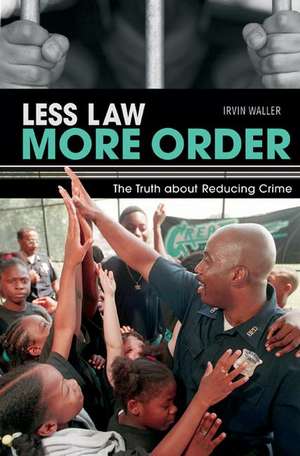Less Law, More Order: The Truth about Reducing Crime
Autor Irvin Walleren Limba Engleză Hardback – 29 aug 2006 – vârsta până la 17 ani
Preț: 345.42 lei
Preț vechi: 476.10 lei
-27% Nou
Puncte Express: 518
Preț estimativ în valută:
66.10€ • 69.18$ • 55.01£
66.10€ • 69.18$ • 55.01£
Carte tipărită la comandă
Livrare economică 31 martie-14 aprilie
Preluare comenzi: 021 569.72.76
Specificații
ISBN-13: 9780275990770
ISBN-10: 027599077X
Pagini: 176
Dimensiuni: 156 x 235 x 19 mm
Greutate: 0.43 kg
Editura: Bloomsbury Publishing
Colecția Praeger
Locul publicării:New York, United States
ISBN-10: 027599077X
Pagini: 176
Dimensiuni: 156 x 235 x 19 mm
Greutate: 0.43 kg
Editura: Bloomsbury Publishing
Colecția Praeger
Locul publicării:New York, United States
Notă biografică
Irvin Waller is Professor of Criminology at University of Ottawa. He is the founding CEO of the International Centre for Prevention of Crime in Montreal. He is the author of Men Released from Prison and Burglary: The Victim and the Public. His most recent work has been in researching and writing policy pamphlets for organizations such as the U.S. Department of Justice, the Canadian Council for Social Development, the Soros Foundation, and the UN European Institute on Crime Prevention and Criminal Justice.
Cuprins
FiguresAcknowledgmentsIntroduction: Truth and Sense, Not GiulianiAbbreviations1 Tough on Crime Is Tough on Us2 Pay to Keep Kids from Crime, Not behind Bars3 Outlaw Violence, Not Men4 Watch Out for Your Own Where Needed5 Police Smarter, Not More6 Guarantee Justice and Support for Crime Victims7 Make Cities Tough on Causes8 Shift from "Pay for Law" to "Invest in Order"9 Conclusion: Bust Causes, Not BudgetsNotesPrincipal SourcesIndex
Recenzii
In nine well-written, clearly documented chapters, Waller makes the case for adopting policies that privilege the prevention of crime over the current tough on crime response. He demonstrates how the punitive approach is actually tough on victims and taxpayers and produces questionable outcomes. The author offers a series of policy proposals that would focus on addressing the known causes of conventional crime, starting with programs to invest in more effective parenting and schooling. Many proposals are quite familiar (e.g., outlaw handguns), and some are especially ambitious (e.g., transform urban environments). Concluding chapters call for investing in order and busting causes, not budgets. Altogether, this brief but well-organized book offers a useful overview of the case for an alternative to the current crime-fighting public policies. Recommended. All public and academic levels/libraries.
[C]hallenges the conventional practices of law enforcement in reacting to crime. He presents scientific research, demonstrating crime prevention projects that have successfully tackled factors at the root of crime. Yet, despite findings by numerous prestigious commissions from both national and international sources, the current response appears to be increased incarceration and police force, which tends to lead to more incarceration. Waller details those programs that have proven successful in reducing crime by helping at-risk youth to complete school and get job training, preventing family violence, restricting hand guns, and addressing drug abuse through public-health services..[t]he clear challenge is to get responsible officials to see that a more effective deterrent to crime is to address social issues that lead to crime rather than the current reactive practice of increasing penalties and reacting to crime after it occurs.
[C]hallenges the conventional practices of law enforcement in reacting to crime. He presents scientific research, demonstrating crime prevention projects that have successfully tackled factors at the root of crime. Yet, despite findings by numerous prestigious commissions from both national and international sources, the current response appears to be increased incarceration and police force, which tends to lead to more incarceration. Waller details those programs that have proven successful in reducing crime by helping at-risk youth to complete school and get job training, preventing family violence, restricting hand guns, and addressing drug abuse through public-health services..[t]he clear challenge is to get responsible officials to see that a more effective deterrent to crime is to address social issues that lead to crime rather than the current reactive practice of increasing penalties and reacting to crime after it occurs.
